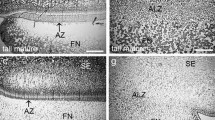Abstract
The primary leaves of the bean (Phaseolus vulgaris c.v. red kidney) are shed as the result of cell wall breakdown in the abscission zones found at the base of the lamina and at the stem–petiole junction. Horton and Osborne1 suggested that cellulase (B l : 4 glucan 4-glucanohydrolase) was involved in this wall hydrolysis because its activity increased considerably during abscission. Although this result has been repeated on a wide range of plant material2, critical scrutiny of the data has led several authors3,4 to question the direct involvement of the enzyme in wall weakening. The following objections have been raised: (1) cellulase may be present at relatively high levels before abscission is induced5, (2) although wall breakdown is confined to two or three layers of cells, cellulase is usually found over a wider area of the petiole, (3) the increase in cellulase which accompanies abscission may not take place until cell separation is essentially complete3, (4) cellulase may increase without concomitant breakdown of the abscission layer4. One possible explanation for these anomalies is that these assays failed to distinguish between the various isozymes of cellulase, of which only one is postulated to be involved in abscission6. Recently, the specific isozyme thought to participate in bean leaf abscission (9.5 cellulase) has been purified and monospecific rabbit antibodies raised against it7. These antibodies do not cross-react with the other form (s) of cellulase and thus can be used both to quantify changes in 9.5 cellulase during abscission and to determine cytochemically the distribution of the enzyme. Using these antibodies, we have now made observations consistent with the participation of cellulase in the wall hydrolysis which leads to fracture.
Similar content being viewed by others
References
Horton, R. F. & Osborne, D. J. Nature 214, 1086–1088 (1967).
Addicott, F. D. & Wiatr, S. M. Proc. 9th int. Conf. Plant Growth Substances (ed. Pilet, P. E.) 249–258 (Springer, Berlin, 1977).
Hanish Ten Gate, Ch. H., Ven Netter, J., Dortland, J. F. & Bruinsma, J. Physiol. Pl. 33, 276–279 (1975).
Huberman, M. & Goren, R. Physiol. Pl. 45, 189–196 (1979).
Lewis, L. N. & Varner, J. E. Pl. Physiol. 46, 194–199 (1970).
Lewis, L. N., Linkins, A. E., O'Sullivan, S. & Reid, P. D. Proc. 8th int. conf. Plant rowth Substances 708–718 (Hirokawa, Tokyo, 1974).
Koehler, D. E., Lewis, L. N., Shannon, L. M. & Durbin, M. L. Phytochemistry (submitted).
Chard, T. in Laboratory Techniques in Biochemistry and Molecular Biology Vol. 6 (eds Work, T. S. & Work, E.) 293–517 (North-Holland, Amsterdam, 1978).
Straus, W. 1st int. Sym. Immunoenzymatic Techniques (eds Feldman, G., Druet, P., Bignon, J. & Avrameas, S.) 117–137 (North-Holland, Amsterdam, 1976).
Graham, R. C. & Karnovsky, M. J. J. Histochem. Cytochem. 14, 291–302 (1966).
Author information
Authors and Affiliations
Rights and permissions
About this article
Cite this article
Sexton, R., Durbin, M., Lewis, L. et al. Use of cellulase antibodies to study leaf abscission. Nature 283, 873–874 (1980). https://doi.org/10.1038/283873a0
Received:
Accepted:
Issue Date:
DOI: https://doi.org/10.1038/283873a0
- Springer Nature Limited
This article is cited by
-
Elymus nutans genes for seed shattering and candidate gene-derived EST-SSR markers for germplasm evaluation
BMC Plant Biology (2019)
-
Cell separation in kiwifruit without development of a specialised detachment zone
BMC Plant Biology (2017)
-
Endogenous and exogenous ethylene induces needle abscission and cellulase activity in post-harvest balsam fir (Abies balsamea L.)
Trees (2011)
-
Methyl jasmonate induces the formation of secondary abscission zone in stem of Bryophyllum calycinum Salisb
Acta Physiologiae Plantarum (2000)
-
The role of cellulase in hormonal regulation of shoot morphogenesis in tobacco callus
Planta (1995)





